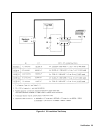
Verification 19
Constant Current (CC) Tests
Test Setup
Connect the appropriate current monitoring resistor (see Table 2-l) as shown in Fig. 2-3. The accuracy of the resistor must
be as specified in the table.
Test Procedures
The test procedures are given in Table 2-5. The tests are independent and may be performed in any order. The CC tests are:
• Current Programming and Readback Accuracy.
• CC Load Effect.
• CC Source Effect.
• CC Noise (PARD).
Table 2-5. Constant Current (CC) Tests
Action Normal Result
Current Programming and Readback Accuracy
This test verifies that the current programming and readback are within specification.
1 Turn off the power supply and connect the current monitoring resistor as
shown in Fig. 2-3. Connect a DVM across the resistor .
2 Turn on the power supply and program the output for 5 volts and 0
amperes.
3 Short the load.
4 Observe the DVM voltage reading. Divide this by the resistance of the
current monitor resistor. Record the result as the Low Current value.
Value within specified Low Current
limits.
5 Record the front panel display readback. Value within specified readback limits.
6 Program output current to full scale (see Table 2-2).
7 Repeat Steps 4 and 5. Both current readings within specified
High Current and readback limits.
CC Noise (PARD)
Periodic and random deviations (PARD) in the output (ripple and noise) combine to produce a residual ac current
superimposed on the dc output current. This test measures CC PARD, specified as the rms output current over the
frequency range of 20 Hz to 20 MHz.
1 Turn off the power supply and connect the current transformer, resistor,
capacitor and rms voltmeter (see Fig. 2-4).


















